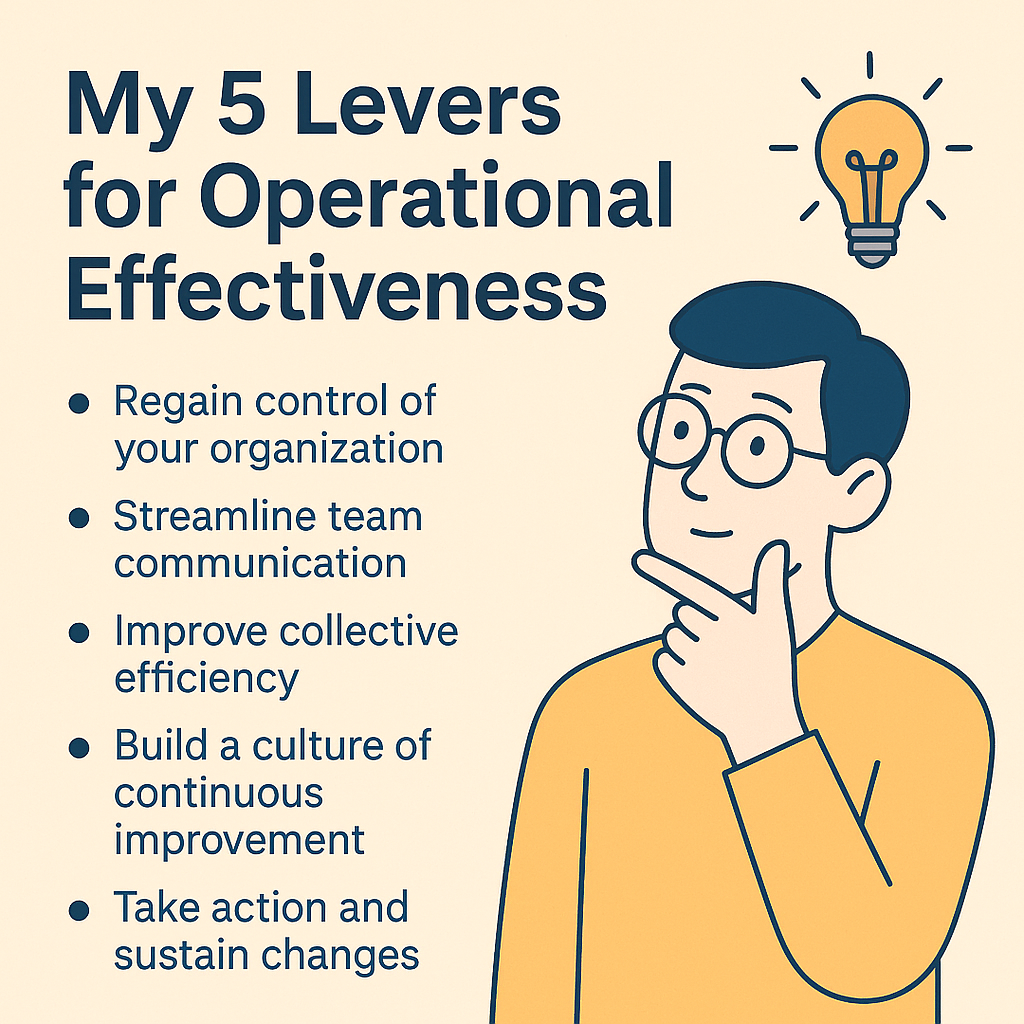Introduction
Across many teams I’ve supported, one observation consistently comes up: efficiency is often held back not by a lack of skill or motivation… but by everyday friction.
Constant interruptions, unclear roles, poorly structured meetings, scattered information — these are subtle yet powerful irritants that accumulate and wear teams down, even when the root cause isn’t easy to identify.
These dysfunctions aren’t dramatic. They’re grains of sand. But stacked together, they block collective momentum, drain motivation, and lower work quality.
To address this, I’ve structured my approach around 5 practical, simple and immediately actionable levers.
🎯 No empty theory, no silver bullets — just tested field strategies to bring back clarity, fluidity, and collective performance.
1️⃣ Regain control over your organization
When priorities are vague and tasks pile up without order, days become unpredictable. This lack of organizational structure creates an invisible mental load that quickly becomes very real. The result? You stay busy, but not necessarily productive.
👉 Clarify priorities: clearly distinguish the urgent from the important to avoid burning out on secondary tasks.
👉 Apply Parkinson’s Law: tasks expand to fill the time allotted. Set realistic but constrained deadlines to avoid sprawl.
👉 Set up light planning rituals: 15 to 30 minutes at the start of the week to align the team on common goals.
👉 Use simple tools: Trello, Notion, or even a shared calendar can do the job if used effectively.
🎯 A product team spent over 3 hours per week organizing priorities across multiple, unsynchronized tools. A 20-minute Trello planning session every Monday reduced mental load and boosted the delivery rate of critical tasks from 60% to 90%.
2️⃣ Streamline communication within the team
Team efficiency depends as much on what is said as how and where it is said. Poorly channeled or misunderstood messages generate noise, confusion, and costly misunderstandings.
👉 Centralize conversations: consolidate messages and info in dedicated tools to avoid scattering.
👉 Define clear channels: each tool has its purpose — Slack for quick updates, Notion for documentation, WhatsApp for emergencies.
👉 Adapt communication modes: not everyone reads or reacts the same way — understanding individual styles makes a difference.
🎯 In a startup, a product team received around 250 Slack messages per day. Too many interruptions, not enough coordination. A batching policy grouped non-urgent messages into two daily time slots. This reduced stress, improved focus, and significantly increased output.
3️⃣ Improve collective efficiency
What makes a team high-performing isn’t the sum of individual efforts, but the quality of collaboration. Unclear roles, ineffective meetings, or an inability to say no can jam the entire system.
👉 Clarify roles: to avoid overlap or gaps in responsibilities.
👉 Structure meetings: every meeting needs a clear goal, an agenda, a time limit, and a facilitator.
👉 Learn to say no: to things that don’t create value. Protect what matters by declining what doesn’t.
👉 Manage surprises wisely: build in buffers, create a backlog for sudden tasks, and avoid blowing up your plans.
🎯 One team was juggling 12 parallel projects with no shared direction. By narrowing focus to three major priorities per two-week sprint and holding regular reviews, perceived workload dropped by half. Team members regained ownership of their goals, and collaboration dynamics improved significantly.
4️⃣ Build a culture of continuous improvement
Improving efficiency doesn’t require radical transformation. What matters is steady, incremental progress that’s shared across the team.
👉 Incorporate frequent feedback: at the end of the week, after a project, or in dedicated sessions.
👉 Encourage micro-adjustments: don’t wait for the “big plan.” A small, well-targeted change often does the trick.
👉 Respect rhythms and personalities: not everyone evolves at the same pace, and that’s okay.
🎯 A development team struggled to voice daily frustrations. A weekly prompt — “what should we keep, what should we improve?” — helped unlock three blockers in just a few weeks: better info organization, clearer goal-setting, and a drastic cut in internal emails.
5️⃣ Take action and anchor the change
Even the best ideas are worthless without action. This final lever is about turning decisions into visible, sustained routines.
👉 Identify 1 to 3 high-impact actions: better to do a few things well than many poorly.
👉 Use the Pomodoro method or action sprints: to turn intent into movement.
👉 Set up light follow-up rituals: visual boards, standups, shared tracking.
🎯 A manager struggled to follow through on improvement goals. A shared team board with one key weekly priority helped resolve five systemic blockers in six weeks. A true culture of change took root.
Conclusion: Working better means simplifying to move forward
Efficiency isn’t about speed or quantity.
It’s about clarity, alignment, and collective momentum.
✅ Regain control over structure.
✅ Streamline communication.
✅ Improve coordination.
✅ Embrace regular feedback.
✅ Turn ideas into anchored action.
👉 What small move could you start tomorrow to gain 10% more efficiency — without adding complexity?
Which of these levers feels most relevant in your context right now? Got an example, a success, or a blocker to share?
I’d love to exchange thoughts in the comments or by DM!


Leave a Reply